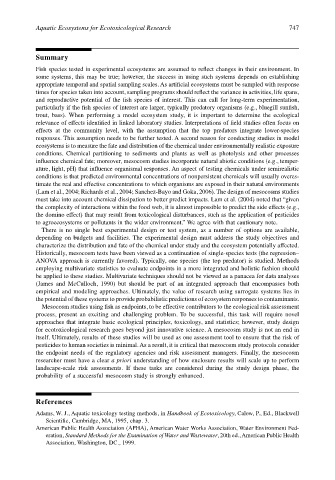Page 767 - The Toxicology of Fishes
P. 767
Aquatic Ecosystems for Ecotoxicological Research 747
Summary
Fish species tested in experimental ecosystems are assumed to reflect changes in their environment. In
some systems, this may be true; however, the success in using such systems depends on establishing
appropriate temporal and spatial sampling scales. As artificial ecosystems must be sampled with response
times for species taken into account, sampling programs should reflect the variance in activities, life spans,
and reproductive potential of the fish species of interest. This can call for long-term experimentation,
particularly if the fish species of interest are larger, typically predatory organisms (e.g., bluegill sunfish,
trout, bass). When performing a model ecosystem study, it is important to determine the ecological
relevance of effects identified in linked laboratory studies. Interpretations of field studies often focus on
effects at the community level, with the assumption that the top predators integrate lower-species
responses. This assumption needs to be further tested. A second reason for conducting studies in model
ecosystems is to measure the fate and distribution of the chemical under environmentally realistic exposure
conditions. Chemical partitioning to sediments and plants as well as photolysis and other processes
influence chemical fate; moreover, mesocosm studies incorporate natural abiotic conditions (e.g., temper-
ature, light, pH) that influence organismal responses. An aspect of testing chemicals under semirealistic
conditions is that predicted environmental concentrations of nonpersistent chemicals will usually overes-
timate the real and effective concentrations to which organisms are exposed in their natural environments
(Lam et al., 2004; Richards et al., 2004; Sanchez-Bayo and Goka, 2006). The design of mesocosms studies
must take into account chemical dissipation to better predict impacts. Lam et al. (2004) noted that “given
the complexity of interactions within the food web, it is almost impossible to predict the side effects (e.g.,
the domino effect) that may result from toxicological disturbances, such as the application of pesticides
to agroecosystems or pollutants in the wider environment.” We agree with that cautionary note.
There is no single best experimental design or test system, as a number of options are available,
depending on budgets and facilities. The experimental design must address the study objectives and
characterize the distribution and fate of the chemical under study and the ecosystem potentially affected.
Historically, mesocosm tests have been viewed as a continuation of single-species tests (the regression–
ANOVA approach is currently favored). Typically, one species (the top predator) is studied. Methods
employing multivariate statistics to evaluate endpoints in a more integrated and holistic fashion should
be applied to these studies. Multivariate techniques should not be viewed as a panacea for data analyses
(James and McCulloch, 1990) but should be part of an integrated approach that encompasses both
empirical and modeling approaches. Ultimately, the value of research using surrogate systems lies in
the potential of these systems to provide probabilistic predictions of ecosystem responses to contaminants.
Mesocosm studies using fish as endpoints, to be effective contributors to the ecological risk assessment
process, present an exciting and challenging problem. To be successful, this task will require novel
approaches that integrate basic ecological principles, toxicology, and statistics; however, study design
for ecotoxicological research goes beyond just innovative science. A mesocosm study is not an end in
itself. Ultimately, results of these studies will be used as one assessment tool to ensure that the risk of
pesticides to human societies is minimal. As a result, it is critical that mesocosm study protocols consider
the endpoint needs of the regulatory agencies and risk assessment managers. Finally, the mesocosm
researcher must have a clear a priori understanding of how enclosure results will scale up to perform
landscape-scale risk assessments. If these tasks are considered during the study design phase, the
probability of a successful mesocosm study is strongly enhanced.
References
Adams, W. J., Aquatic toxicology testing methods, in Handbook of Ecotoxicology, Calow, P., Ed., Blackwell
Scientific, Cambridge, MA, 1995, chap. 3.
American Public Health Association (APHA), American Water Works Association, Water Environment Fed-
eration, Standard Methods for the Examination of Water and Wastewater, 20th ed., American Public Health
Association, Washington, DC., 1999.

